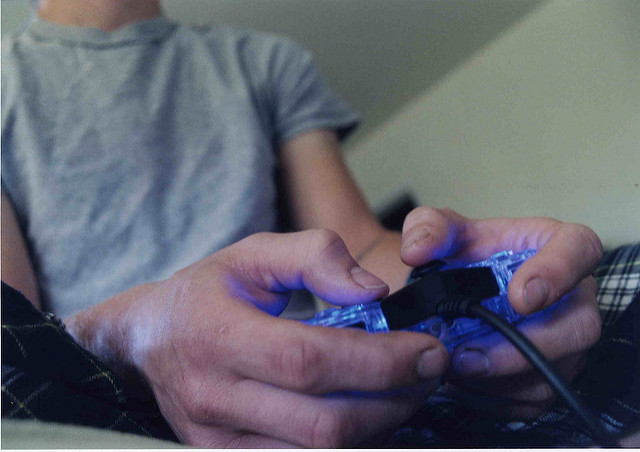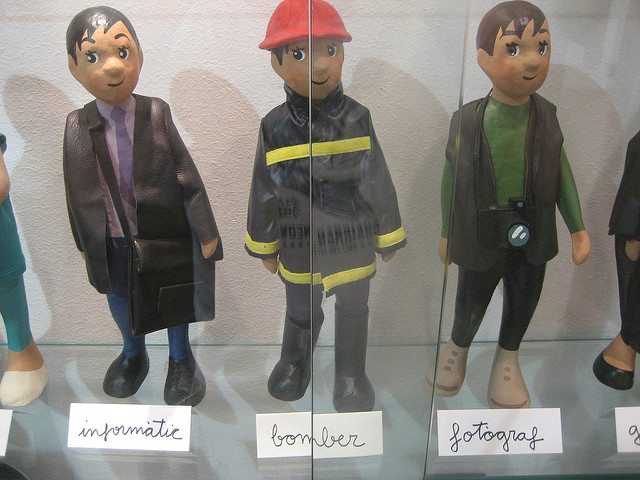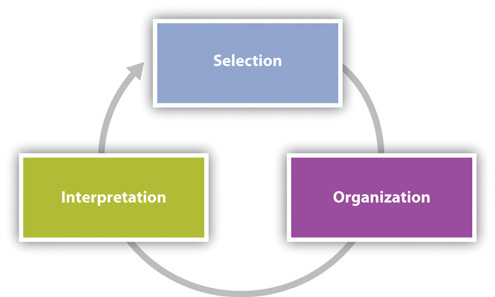Learning Objectives
- Define perception.
- Discuss how salience influences the selection of perceptual information.
- Explain the ways in which we organize perceptual information.
- Discuss the role of schemata in the interpretation of perceptual information.
Perception is the process of selecting, organizing, and interpreting information. This process, which is shown in Figure 2.1 “The Perception Process”, includes the perception of select stimuli that pass through our perceptual filters, are organized into our existing structures and patterns, and are then interpreted based on previous experiences. Although perception is a largely cognitive and psychological process, how we perceive the people and objects around us affects our communication. We respond differently to an object or person that we perceive favorably than we do to something we find unfavorable. But how do we filter through the mass amounts of incoming information, organize it, and make meaning from what makes it through our perceptual filters and into our social realities?
Selecting Information
We take in information through all five of our senses, but our perceptual field (the world around us) includes so many stimuli that it is impossible for our brains to process and make sense of it all. So, as information comes in through our senses, various factors influence what actually continues on through the perception process (Fiske & Taylor, 1991). Selecting is the first part of the perception process, in which we focus our attention on certain incoming sensory information. Think about how, out of many other possible stimuli to pay attention to, you may hear a familiar voice in the hallway, see a pair of shoes you want to buy from across the mall, or smell something cooking for dinner when you get home from work. We quickly cut through and push to the background all kinds of sights, smells, sounds, and other stimuli, but how do we decide what to select and what to leave out?
We tend to pay attention to information that is salient. Salience is the degree to which something attracts our attention in a particular context. The thing attracting our attention can be abstract, like a concept, or concrete, like an object. For example, a person’s identity as a Native American may become salient when they are protesting at the Columbus Day parade in Denver, Colorado. Or a bright flashlight shining in your face while camping at night is sure to be salient. The degree of salience depends on three features (Fiske & Tayor, 1991). We tend to find salient things that are visually or aurally stimulating and things that meet our needs or interests. Lastly, expectations affect what we find salient.
Visual and Aural Stimulation
It is probably not surprising to learn that visually and/or aurally stimulating things become salient in our perceptual field and get our attention. Creatures ranging from fish to hummingbirds are attracted to things like silver spinners on fishing poles or red and yellow bird feeders. Having our senses stimulated isn’t always a positive thing though. Think about the couple that won’t stop talking during the movie or the upstairs neighbor whose subwoofer shakes your ceiling at night. In short, stimuli can be attention-getting in a productive or distracting way. As communicators, we can use this knowledge to our benefit by minimizing distractions when we have something important to say. It’s probably better to have a serious conversation with a significant other in a quiet place rather than a crowded food court. As we will learn later in Chapter 12 “Public Speaking in Various Contexts”, altering the rate, volume, and pitch of your voice, known as vocal variety, can help keep your audience engaged, as can gestures and movement. Conversely, nonverbal adaptors, or nervous movements we do to relieve anxiety like pacing or twirling our hair, can be distracting. Aside from minimizing distractions and delivering our messages enthusiastically, the content of our communication also affects salience.
Needs and Interests
We tend to pay attention to information that we perceive to meet our needs or interests in some way. This type of selective attention can help us meet instrumental needs and get things done. When you need to speak with a financial aid officer about your scholarships and loans, you sit in the waiting room and listen for your name to be called. Paying close attention to whose name is called means you can be ready to start your meeting and hopefully get your business handled. When we don’t think certain messages meet our needs, stimuli that would normally get our attention may be completely lost. Imagine you are in the grocery store and you hear someone say your name. You turn around, only to hear that person say, “Finally! I said your name three times. I thought you forgot who I was!” A few seconds before, when you were focused on figuring out which kind of orange juice to get, you were attending to the various pulp options to the point that you tuned other stimuli out, even something as familiar as the sound of someone calling your name. Again, as communicators, especially in persuasive contexts, we can use this to our advantage by making it clear how our message or proposition meets the needs of our audience members. Whether a sign helps us find the nearest gas station, the sound of a ringtone helps us find our missing cell phone, or a speaker tells us how avoiding processed foods will improve our health, we select and attend to information that meets our needs.

If you’re engrossed in an interesting video game, you may not notice other perceptual cues.
R Pollard – tex playing video games – CC BY 2.0.
We also find salient information that interests us. Of course, many times, stimuli that meet our needs are also interesting, but it’s worth discussing these two items separately because sometimes we find things interesting that don’t necessarily meet our needs. I’m sure we’ve all gotten sucked into a television show, video game, or random project and paid attention to that at the expense of something that actually meets our needs like cleaning or spending time with a significant other. Paying attention to things that interest us but don’t meet specific needs seems like the basic formula for procrastination that we are all familiar with.
In many cases we know what interests us and we automatically gravitate toward stimuli that match up with that. For example, as you filter through radio stations, you likely already have an idea of what kind of music interests you and will stop on a station playing something in that genre while skipping right past stations playing something you aren’t interested in. Because of this tendency, we often have to end up being forced into or accidentally experiencing something new in order to create or discover new interests. For example, you may not realize you are interested in Asian history until you are required to take such a course and have an engaging professor who sparks that interest in you. Or you may accidentally stumble on a new area of interest when you take a class you wouldn’t otherwise because it fits into your schedule. As communicators, you can take advantage of this perceptual tendency by adapting your topic and content to the interests of your audience.
Expectations
The relationship between salience and expectations is a little more complex. Basically, we can find expected things salient and find things that are unexpected salient. While this may sound confusing, a couple examples should illustrate this point. If you are expecting a package to be delivered, you might pick up on the slightest noise of a truck engine or someone’s footsteps approaching your front door. Since we expect something to happen, we may be extra tuned in to clues that it is coming. In terms of the unexpected, if you have a shy and soft-spoken friend who you overhear raising the volume and pitch of his voice while talking to another friend, you may pick up on that and assume that something out of the ordinary is going on. For something unexpected to become salient, it has to reach a certain threshold of difference. If you walked into your regular class and there were one or two more students there than normal, you may not even notice. If you walked into your class and there was someone dressed up as a wizard, you would probably notice. So, if we expect to experience something out of the routine, like a package delivery, we will find stimuli related to that expectation salient. If we experience something that we weren’t expecting and that is significantly different from our routine experiences, then we will likely find it salient. We can also apply this concept to our communication. I always encourage my students to include supporting material in their speeches that defies our expectations. You can help keep your audience engaged by employing good research skills to find such information.
There is a middle area where slight deviations from routine experiences may go unnoticed because we aren’t expecting them. To go back to the earlier example, if you aren’t expecting a package, and you regularly hear vehicle engines and sidewalk foot traffic outside your house, those pretty routine sounds wouldn’t be as likely to catch your attention, even if it were slightly more or less traffic than expected. This is because our expectations are often based on previous experience and patterns we have observed and internalized, which allows our brains to go on “autopilot” sometimes and fill in things that are missing or overlook extra things. Look at the following sentence and read it aloud: Percpetoin is bsaed on pateetrns, maening we otfen raech a cocnlsuion witouht cosnidreing ecah indviidaul elmenet. This example illustrates a test of our expectation and an annoyance to every college student. We have all had the experience of getting a paper back with typos and spelling errors circled. This can be frustrating, especially if we actually took the time to proofread. When we first learned to read and write, we learned letter by letter. A teacher or parent would show us a card with A-P-P-L-E written on it, and we would sound it out. Over time, we learned the patterns of letters and sounds and could see combinations of letters and pronounce the word quickly. Since we know what to expect when we see a certain pattern of letters, and know what comes next in a sentence since we wrote the paper, we don’t take the time to look at each letter as we proofread. This can lead us to overlook common typos and spelling errors, even if we proofread something multiple times. As a side note, I’ll share two tips to help you avoid proofreading errors: First, have a friend proofread your paper. Since they didn’t write it, they have fewer expectations regarding the content. Second, read your papers backward. Since patterns of speech aren’t the same in reverse you have to stop and focus on each word. Now that we know how we select stimuli, let’s turn our attention to how we organize the information we receive.
Organizing Information
Organizing is the second part of the perception process, in which we sort and categorize information that we perceive based on innate and learned cognitive patterns. Three ways we sort things into patterns are by using proximity, similarity, and difference (Coren, 1980). In terms of proximity, we tend to think that things that are close together go together. For example, have you ever been waiting to be helped in a business and the clerk assumes that you and the person standing beside you are together? The slightly awkward moment usually ends when you and the other person in line look at each other, then back at the clerk, and one of you explains that you are not together. Even though you may have never met that other person in your life, the clerk used a basic perceptual organizing cue to group you together because you were standing in proximity to one another.

Since we organize perceptual information based on proximity, a person may perceive that two people are together, just because they are standing close together in line.
Wikimedia Commons – public domain.
We also group things together based on similarity. We tend to think similar-looking or similar-acting things belong together. I have two friends that I occasionally go out with, and we are all three males, around the same age, of the same race, with short hair and glasses. Aside from that, we don’t really look alike, but on more than one occasion a server at a restaurant has assumed that we’re brothers. Despite the fact that many of our other features are different, the salient features are organized based on similarity and the three of us are suddenly related.
We also organize information that we take in based on difference. In this case, we assume that the item that looks or acts different from the rest doesn’t belong with the group. Perceptual errors involving people and assumptions of difference can be especially awkward, if not offensive. My friend’s mother, who is Vietnamese American, was attending a conference at which another attendee assumed she was a hotel worker and asked her to throw something away for her. In this case, my friend’s mother was a person of color at a convention with mostly white attendees, so an impression was formed based on the other person’s perception of this difference.
These strategies for organizing information are so common that they are built into how we teach our children basic skills and how we function in our daily lives. I’m sure we all had to look at pictures in grade school and determine which things went together and which thing didn’t belong. If you think of the literal act of organizing something, like your desk at home or work, we follow these same strategies. If you have a bunch of papers and mail on the top of your desk, you will likely sort papers into separate piles for separate classes or put bills in a separate place than personal mail. You may have one drawer for pens, pencils, and other supplies and another drawer for files. In this case you are grouping items based on similarities and differences. You may also group things based on proximity, for example, by putting financial items like your checkbook, a calculator, and your pay stubs in one area so you can update your budget efficiently. In summary, we simplify information and look for patterns to help us more efficiently communicate and get through life.
Simplification and categorizing based on patterns isn’t necessarily a bad thing. In fact, without this capability we would likely not have the ability to speak, read, or engage in other complex cognitive/behavioral functions. Our brain innately categorizes and files information and experiences away for later retrieval, and different parts of the brain are responsible for different sensory experiences. In short, it is natural for things to group together in some ways. There are differences among people, and looking for patterns helps us in many practical ways. However, the judgments we place on various patterns and categories are not natural; they are learned and culturally and contextually relative. Our perceptual patterns do become unproductive and even unethical when the judgments we associate with certain patterns are based on stereotypical or prejudicial thinking.
We also organize interactions and interpersonal experiences based on our firsthand experiences. When two people experience the same encounter differently, misunderstandings and conflict may result. Punctuation refers to the structuring of information into a timeline to determine the cause (stimulus) and effect (response) of our communication interactions (Sillars, 1980). Applying this concept to interpersonal conflict can help us see how the perception process extends beyond the individual to the interpersonal level. This concept also helps illustrate how organization and interpretation can happen together and how interpretation can influence how we organize information and vice versa.
Where does a conflict begin and end? The answer to this question depends on how the people involved in the conflict punctuate, or structure, their conflict experience. Punctuation differences can often escalate conflict, which can lead to a variety of relationship problems (Watzlawick, Bavelas, & Jackson, 1967). For example, Linda and Joe are on a project team at work and have a deadline approaching. Linda has been working on the project over the weekend in anticipation of her meeting with Joe first thing Monday morning. She has had some questions along the way and has e-mailed Joe for clarification and input, but he hasn’t responded. On Monday morning, Linda walks into the meeting room, sees Joe, and says, “I’ve been working on this project all weekend and needed your help. I e-mailed you three times! What were you doing?” Joe responds, “I had no idea you e-mailed me. I was gone all weekend on a camping trip.” In this instance, the conflict started for Linda two days ago and has just started for Joe. So, for the two of them to most effectively manage this conflict, they need to communicate so that their punctuation, or where the conflict started for each one, is clear and matches up. In this example, Linda made an impression about Joe’s level of commitment to the project based on an interpretation she made after selecting and organizing incoming information. Being aware of punctuation is an important part of perception checking, which we will discuss later. Let’s now take a closer look at how interpretation plays into the perception process.
Interpreting Information
Although selecting and organizing incoming stimuli happens very quickly, and sometimes without much conscious thought, interpretation can be a much more deliberate and conscious step in the perception process. Interpretation is the third part of the perception process, in which we assign meaning to our experiences using mental structures known as schemata. Schemata are like databases of stored, related information that we use to interpret new experiences. We all have fairly complicated schemata that have developed over time as small units of information combine to make more meaningful complexes of information.

Schemata are like lenses that help us make sense of the perceptual cues around us based on previous knowledge and experience.
Darren Shaw – Glasses – CC BY-NC 2.0.
We have an overall schema about education and how to interpret experiences with teachers and classmates. This schema started developing before we even went to preschool based on things that parents, peers, and the media told us about school. For example, you learned that certain symbols and objects like an apple, a ruler, a calculator, and a notebook are associated with being a student or teacher. You learned new concepts like grades and recess, and you engaged in new practices like doing homework, studying, and taking tests. You also formed new relationships with teachers, administrators, and classmates. As you progressed through your education, your schema adapted to the changing environment. How smooth or troubling schema reevaluation and revision is varies from situation to situation and person to person. For example, some students adapt their schema relatively easily as they move from elementary, to middle, to high school, and on to college and are faced with new expectations for behavior and academic engagement. Other students don’t adapt as easily, and holding onto their old schema creates problems as they try to interpret new information through old, incompatible schema. We’ve all been in a similar situation at some point in our lives, so we know that revising our schemata can be stressful and that such revision takes effort and usually involves some mistakes, disappointments, and frustrations. But being able to adapt our schemata is a sign of cognitive complexity, which is an important part of communication competence. So, even though the process may be challenging, it can also be a time for learning and growth.
It’s important to be aware of schemata because our interpretations affect our behavior. For example, if you are doing a group project for class and you perceive a group member to be shy based on your schema of how shy people communicate, you may avoid giving him presentation responsibilities in your group project because you do not think shy people make good public speakers. Schemata also guide our interactions, providing a script for our behaviors. We know, in general, how to act and communicate in a waiting room, in a classroom, on a first date, and on a game show. Even a person who has never been on a game show can develop a schema for how to act in that environment by watching The Price Is Right, for example. People go to great lengths to make shirts with clever sayings or act enthusiastically in hopes of being picked to be a part of the studio audience and hopefully become a contestant on the show.

We often include what we do for a living in our self-introductions, which then provides a schema through which others interpret our communication.
David Weekly – Professions! – CC BY 2.0.
As we have seen, schemata are used to interpret others’ behavior and form impressions about who they are as a person. To help this process along, we often solicit information from people to help us place them into a preexisting schema. In the United States and many other Western cultures, people’s identities are often closely tied to what they do for a living. When we introduce others, or ourselves, occupation is usually one of the first things we mention. Think about how your communication with someone might differ if he or she were introduced to you as an artist versus a doctor. We make similar interpretations based on where people are from, their age, their race, and other social and cultural factors. We will learn more about how culture, gender, and other factors influence our perceptions as we continue through the chapter. In summary, we have schemata about individuals, groups, places, and things, and these schemata filter our perceptions before, during, and after interactions. As schemata are retrieved from memory, they are executed, like computer programs or apps on your smartphone, to help us interpret the world around us. Just like computer programs and apps must be regularly updated to improve their functioning, competent communicators update and adapt their schemata as they have new experiences.
“Getting Real”
Police Officers, Schemata, and Perception/Interpretation
Prime-time cable and network television shows like the Law and Order franchise and Southland have long offered viewers a glimpse into the lives of law enforcement officers. COPS, the first and longest-running prime-time reality television show, and newer reality-themed and educational shows like The First 48 and Lockdown, offer a more realistic look into techniques used by law enforcement. Perception is a crucial part of an officer’s skill set. Specifically, during police-citizen encounters, where tensions may be high and time for decision making limited, officers rely on schemata developed through personal experience off the job and training and experience on the job (Rozelle & Baxter, 1975). Moreover, police officers often have to make perceptions based on incomplete and sometimes unreliable information. So, how do police officers use perception to help them do their jobs?
Research has examined how police officers use perception to make judgments about personality traits, credibility, deception, and the presence or absence of a weapon, among others things, and just like you and me, officers use the same process of selection, organization, and interpretation. This research has found that officers, like us, rely on schema to help them make decisions under time and situational constraints. In terms of selection, expectations influence officer perception. At preshift meetings, officers are briefed on ongoing issues and “things to be on the lookout for,” which provides them with a set of expectations—for example, the make and model of a stolen car—that can guide their selection process. They must also be prepared for things that defy their expectations, which is not a job skill that many other professionals have to consider every day. They never know when a traffic stop could turn into a pursuit or a seemingly gentle person could turn violent. These expectations can then connect to organization strategies. For example, if an officer knows to be alert for a criminal suspect, they will actively organize incoming perceptual information into categories based on whether or not people look similar to or different from the suspect description. Proximity also plays into police work. If a person is in a car with a driver who has an unregistered handgun, the officer is likely to assume that the other person also has criminal intent. While these practices are not inherently bad, there are obvious problems that can develop when these patterns become rigid schema. Some research has shown that certain prejudices based on racial schema can lead to perceptual errors—in this case, police officers mistakenly perceiving a weapon in the possession of black suspects more often than white suspects (Payne, 2001). Additionally, racial profiling (think of how profiles are similar to schemata) has become an issue that’s gotten much attention since the September 11, 2001, terrorist attacks and the passage of immigration laws in states like Arizona and Alabama that have been critiqued as targeting migrant workers and other undocumented immigrants. As you can see, law enforcement officers and civilians use the same perception process, but such a career brings with it responsibilities and challenges that highlight the imperfect nature of the perception process.
- What communication skills do you think are key for a law enforcement officer to have in order to do their job effectively and why?
- Describe an encounter that you have had with a law enforcement officer (if you haven’t had a direct experience you can use a hypothetical or fictional example). What were your perceptions of the officer? What do you think his or her perceptions were of you? What schemata do you think contributed to each of your interpretations?
- What perceptual errors create potential ethical challenges in law enforcement? For example, how should the organizing principles of proximity, similarity, and difference be employed?
Key Takeaways
- Perception is the process of selecting, organizing, and interpreting information. This process affects our communication because we respond to stimuli differently, whether they are objects or persons, based on how we perceive them.
- Given the massive amounts of stimuli taken in by our senses, we only select a portion of the incoming information to organize and interpret. We select information based on salience. We tend to find salient things that are visually or aurally stimulating and things that meet our needs and interests. Expectations also influence what information we select.
- We organize information that we select into patterns based on proximity, similarity, and difference.
- We interpret information using schemata, which allow us to assign meaning to information based on accumulated knowledge and previous experience.
Exercises
- Take a moment to look around wherever you are right now. Take in the perceptual field around you. What is salient for you in this moment and why? Explain the degree of salience using the three reasons for salience discussed in this section.
- As we organize information (sensory information, objects, and people) we simplify and categorize information into patterns. Identify some cases in which this aspect of the perception process is beneficial. Identify some cases in which it could be harmful or negative.
- Getting integrated: Think about some of the schemata you have that help you make sense of the world around you. For each of the following contexts—academic, professional, personal, and civic—identify a schema that you commonly rely on or think you will rely on. For each schema you identified note a few ways that it has already been challenged or may be challenged in the future.
References
Coren, S., “Principles of Perceptual Organization and Spatial Distortion: The Gestalt Illusions,” Journal of Experimental Psychology: Human Perception and Performance 6, no. 3 (1980): 404–12.
Fiske, S. T., and Shelley E. Taylor, Social Cognition, 2nd ed. (New York, NY: McGraw Hill, 1991).
Payne, B. K., “Prejudice and Perception: The Role of Automatic and Controlled Processes in Misperceiving a Weapon,” Journal of Personality and Social Psychology 81, no. 2 (2001): 181–92.
Rozelle, R. M., and James C. Baxter, “Impression Formation and Danger Recognition in Experienced Police Officers,” Journal of Social Psychology 96 (1975): 54.
Sillars, A. L., “Attributions and Communication in Roommate Conflicts,” Communication Monographs 47, no. 3 (1980): 180–200.
Watzlawick, P., Janet Beavin Bavelas, and Don D. Jackson, Pragmatics of Human Communication: A Study of Interactional Patterns, Pathologies, and Paradoxes (New York, NY: W. W. Norton, 1967), 56.


